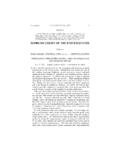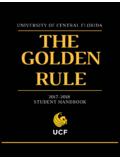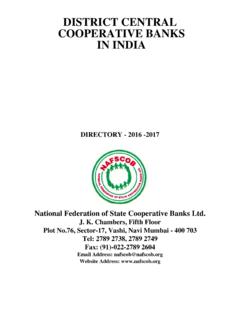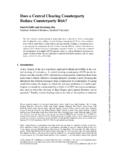Transcription of Unaccompanied Alien Children: An Overview
1 Unaccompanied Alien Children: An Overview William A. Kandel Analyst in Immigration Policy January 18, 2017 congressional research Service 7-5700 R43599 Unaccompanied Alien Children: An Overview congressional research Service Summary In FY2014, the number of Unaccompanied Alien children (UAC, Unaccompanied children) that were apprehended at the Southwest border while attempting to enter the United States without authorization reached a peak, straining the system put in place over the past decade to handle such cases. Prior to FY2014, UAC apprehensions were steadily increasing. For example, in FY2011, the Border Patrol (USBP) apprehended 16,067 Unaccompanied children at the Southwest border, whereas in FY2014 more than 68,500 Unaccompanied children were apprehended. In FY2015, UAC apprehensions declined 42% to 39,970.
2 At the close of FY2016 they increased to 59,692, roughly 20,000 more than in FY2015, and 9,000 less than the peak of FY2014. During the first two months of FY2017 (October and November, 2016), USBP apprehended 14,128 Unaccompanied children. Apprehensions in the first two months of FY2015 and FY2016 were 5,143 and 10,588, respectively. UAC are defined in statute as children who lack lawful immigration status in the United States, who are under the age of 18, and who either are without a parent or legal guardian in the United States or without a parent or legal guardian in the United States who is available to provide care and physical custody. Two statutes and a legal settlement directly affect policy for the treatment and administrative processing of UAC: the Trafficking Victims Protection Reauthorization Act of 2008 ( 110-457); the Homeland Security Act of 2002 ( 107-296); and the Flores Settlement Agreement of 1997.
3 Agencies in the Department of Homeland Security (DHS) and the Department of Health and Human services (HHS) share responsibility for the processing, treatment, and placement of UAC. DHS s Customs and Border Protection (CBP) apprehends and detains Unaccompanied children arrested at the border. DHS s Immigration and Customs Enforcement (ICE) handles custody transfer and repatriation responsibilities, apprehends UAC in the interior of the country, and represents the government in removal proceedings. HHS s Office of Refugee Resettlement (ORR) coordinates and implements the care and placement of Unaccompanied children in appropriate custody. Foreign nationals from El Salvador, Guatemala, Honduras, and Mexico accounted for almost all UAC cases in recent years, especially in FY2014. In FY2009, Mexico accounted for 82% of the 19,688 UAC apprehensions at the Southwest border, while the other three Central American countries accounted for 17%.
4 In FY2014, the proportions had almost reversed, with Mexican nationals comprising 23% of UAC apprehensions and the three Central American countries comprising 77%. In FY2016, Mexican nationals made up 20% of all UAC apprehensions. To address the crisis at its peak in 2014, the Obama Administration developed a working group to coordinate the efforts of federal agencies involved. It also opened additional shelters and holding facilities to accommodate the large number of UAC apprehended at the border. In June 2014, the Administration announced plans to provide funding to the affected Central American countries for a variety of programs and security-related initiatives to mitigate the flow of Unaccompanied migrant children. In July 2014, the Administration requested, and Congress debated but did not approve, $ billion in FY2014 supplemental appropriations to address the crisis.
5 For FY2015, Congress appropriated nearly $ billion for the Refugee and Entrant Assistance Programs in ORR, most of which was directed toward the UAC program ( 113-235). For DHS agencies, Congress appropriated $ billion for detection, enforcement, and removal operations, including for the transport of Unaccompanied children for CBP. The Department of Homeland Security Appropriations Act, FY2015 ( 114-4) also allowed the Secretary of Homeland Security to reprogram funds within CBP and ICE and transfer such funds into the two Unaccompanied Alien Children: An Overview congressional research Service agencies Salaries and Expenses accounts for the care and transportation of Unaccompanied children. The act also allowed for several DHS grants awarded to states along the Southwest border to be used by recipients for costs or reimbursement of costs related to providing humanitarian relief to Unaccompanied children.
6 Congress continued to provide base funding at comparable levels for FY2016, but did not appropriate funds for contingency funding that was requested by the Administration to address potential surges in UAC flows. Congress has passed two continuing resolutions to fund ORR for FY2017 ( 114-223 and 114-254), both of which maintain funding at levels and conditions comparable to FY2016. For both resolutions, Congress has granted HHS the authority to transfer funds from other HHS budget accounts to address higher than anticipated caseloads. The second CR also contains a special anomaly provision authorizing HHS to transfer $300 million to fund ORR programs dedicated to Unaccompanied children as of February 1, 2017. After March 1, 2017, if the UAC caseload for FY2017 exceeds by 40% the UAC caseload for the comparable FY2016 period, the CR will appropriate an additional $200 million in new funding.
7 Unaccompanied Alien Children: An Overview congressional research Service Contents Background .. 1 Scope of the Issue .. 2 Current Policy .. 3 Processing and Treatment of Apprehended UAC .. 4 Customs and Border 5 Immigration and Customs Enforcement .. 7 Office of Refugee Resettlement .. 8 Citizenship and Immigration services .. 10 The Executive Office for Immigration Review .. 11 Administrative and congressional Action .. 13 Administrative Action .. 13 congressional Action .. 14 Appropriations .. 15 Going Forward .. 17 Figures Figure 1. UAC Apprehensions at the Southwest Border by Country of Origin, FY2008 - FY2017 .. 2 Figure 2. UACs Apprehended and Referred to ORR Custody, FY2008 - FY2016 .. 9 Tables Table 1. UAC Initial Case Completion by Outcome and Legal Representation .. 12 Contacts Author Contact Information.
8 18 Unaccompanied Alien Children: An Overview congressional research Service 1 Background After several years of increases, the number of Unaccompanied alien1 children (UAC) apprehended at the Southwest border by the Department of Homeland Security s (DHS s) Customs and Border Protection (CBP) peaked at 68,541 in FY2014. Some Members of Congress as well as the Obama Administration have characterized the issue as a humanitarian The reasons why they migrate to the United States are often multifaceted and difficult to measure analytically. The congressional research Service (CRS) has analyzed several out-migration-related factors, such as violent crime rates, economic conditions, rates of poverty, and the presence of transnational CRS also has analyzed in-migration-related factors, such as the search for economic opportunity, the desire to reunite with family members, and immigration policies.
9 Some have suggested that the sizable increase in UAC flows in recent years results from a perception of relaxed immigration policies toward children under the Obama These critics also cite a 2008 law5 that treats UAC from contiguous countries differently than those from noncontiguous countries (see the section Customs and Border Protection ). Unaccompanied Alien children are defined in statute as children who: lack lawful immigration status in the United States;6 are under the age of 18; and are without a parent or legal guardian in the United States or without a parent or legal guardian in the United States who is available to provide care and physical They most often arrive at ports of entry or are apprehended along the southwestern border with Mexico. Less frequently, they are apprehended in the interior of the country and determined to be juveniles and Although most are age 14 or older, apprehensions of UAC under age 13 have 1 Alien , a technical term appearing throughout the Immigration and Nationality Act (INA), refers to a foreign national who is not a citizen or national of the United States.
10 2 Senate Judiciary Committee hearing on Oversight of the Department of Homeland Security, June 11, 2014 (hereinafter referred to as Senate Oversight Hearing). 3 See CRS Report R43628, Unaccompanied Alien Children: Potential Factors Contributing to Recent Immigration. 4 These critics often cite the Border Security, Economic Opportunity, and Immigration Modernization Act (S. 744, 113th Congress), passed by the Senate in 2013, which would allow certain unlawfully present aliens to adjust to a lawful immigration status; and the administrative policy entitled Deferred Action for Childhood Arrivals (DACA), which grants certain aliens who arrived in the United States as children prior to a certain period some protection from removal for at least two years. For an example of these arguments, see Congress, Senate Committee on the Judiciary, Oversight of the Department of Homeland Security, 113th Cong.















